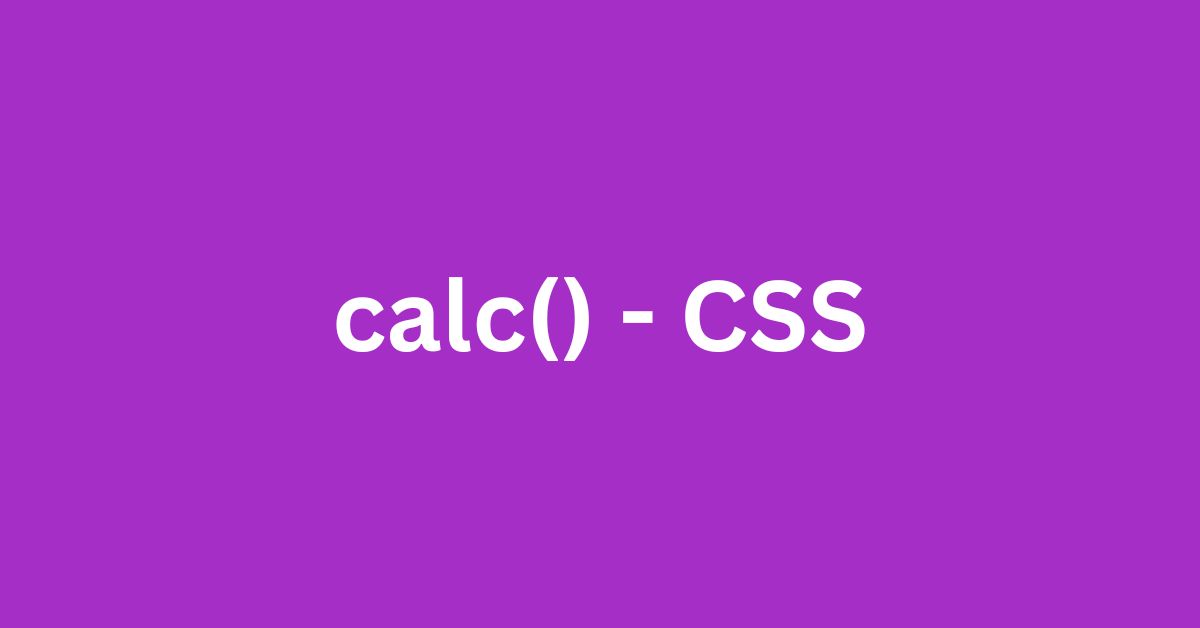|
Getting your Trinity Audio player ready... |
Introduction to calc() in CSS
What is calc()?
The calc() is a function, which allows you to perform basic mathematical operations—like addition, subtraction, multiplication, and division—directly within your CSS property values. This provides you with more flexibility when designing dynamic, responsive layouts without requiring additional JavaScript or overly complex media queries.
For example:
width: calc(100% - 50px);This sets the element’s width to fill the entire container minus 50 pixels.
Why calc() Matters in Modern Web Design
Modern web development focuses on responsive design, fluid layouts, and accessibility. calc() allows developers to create layouts that intelligently adjust to various screen sizes and content conditions—without losing precision. It’s especially helpful when you need to blend relative units like percentages with fixed units like pixels or rems.
Syntax and Basic Usage
General Syntax Rules
The syntax is simple:
property: calc(expression);
Inside the calc() function, you can use the following operators:
+(addition)-(subtraction)*(multiplication)/(division)
Spaces must always surround operators, or your CSS may break.
Supported Units and Operations
You can mix units like:
%(percentage)px(pixels)em,remvw,vh(viewport units)
For example:
font-size: calc(1rem + 2vw);
Common Mistakes to Avoid
- Forgetting spaces around operators:
calc(100%-50px)won’t work, butcalc(100% - 50px)will. - Mixing incompatible units:
calc(1s + 10px)doesn’t make sense. - Using
calc()where it’s not supported—like in shorthand properties (margin: calc(...) calc(...)).
How calc() Works Under the Hood
Combining Absolute and Relative Units
One of the strongest advantages of calc() is the ability to combine units like % and px seamlessly. This helps when an element should take full width minus a known fixed-size component like padding or margins.
CSS Engine Evaluation Timing
CSS evaluates calc() expressions during layout calculation, after loading and applying styles but before painting. It doesn’t re-evaluate unless layout-affecting properties change.
Practical Examples of calc() Usage
Dynamic Width and Height
.container {
width: calc(100% - 20px);
}
Centering Elements
Combine calc() with position to center:
left: calc(50% - 150px); /* Element width: 300px */
Creating Spacing and Margins
Set padding responsively:
padding: calc(1rem + 2vw);
calc() vs CSS Variables
Key Differences
calc()does math; CSS variables store reusable values.- CSS variables can be dynamic and updated using JavaScript.
When to Use One Over the Other
Use calc() for computations; use variables for reuse and maintainability. Often, they work best together.
:root {
--gap: 20px;
}
.container {
margin: calc(var(--gap) * 2);
}
Nested calc() Functions – Are They Possible?
What Works and What Doesn’t
You can’t nest calc() directly like calc(calc(50% - 10px) / 2). Instead, simplify:
width: calc((50% - 10px) / 2);
Workarounds and Tips
Break complex math into multiple CSS properties or use CSS variables to break logic apart.
Browser Support for calc()
Compatibility Chart
| Browser | Support | Since Version |
|---|---|---|
| Chrome | ✅ Full | 26+ |
| Firefox | ✅ Full | 16+ |
| Safari | ✅ Full | 6+ |
| Edge (Chromium) | ✅ Full | 79+ |
| Internet Explorer | ⚠️ Partial | 9+ (with bugs) |
Known Issues and Fallbacks
Older IE browsers have limited support. For critical layouts, provide fallback values or use feature detection with @supports.
Performance Impact of calc()
Rendering Time Considerations
The overhead of calc() is negligible for most use cases. It’s resolved at runtime like any other CSS rule.
Effects on Reflows and Repaints
Because calc() ties into layout calculations, changes can trigger reflows. Minimize layout thrashing for performance.
calc() with Flexbox and Grid Layouts
Smart Layout Tricks
Combine calc() with flex-basis:
flex: 0 0 calc(33.333% - 20px);
Example with Grid Columns
grid-template-columns: calc(50% - 10px) auto;
Combining calc() with Media Queries
Responsive Designs with Precision
@media (min-width: 768px) {
.sidebar {
width: calc(100% - 300px);
}
}
Controlling Layout with Viewport Units
padding: calc(2vw + 10px);
Using calc() in Animations and Transitions
Dynamic Motion Effects
You can animate calc-based properties:
transition: width 0.3s ease;
width: calc(100% - 30px);
Accessibility Considerations
Font Scaling with calc()
Blend fixed and relative sizing:
font-size: calc(1rem + 1vw);
Layout Fluidity for Screen Readers
Proper use of calc() ensures visual layouts scale fluidly with zoom and device sizes, benefiting accessibility.
FAQs about calc() – CSS
1. Can I use calc() with all CSS properties?
Not quite. calc() works with many properties that accept numerical values—like width, margin, padding, font-size, and transform. However, it doesn’t work in some shorthand properties or values that require non-numeric content, like display or position.
2. Is it safe to use calc() in production websites?
Absolutely! calc() is well-supported across all modern browsers, including Chrome, Firefox, Safari, Edge, and even Internet Explorer 9+. It’s safe for most production use cases, especially when combined with fallback values where necessary.
3. Can I animate properties that use calc()?
Yes, you can animate properties like width, height, margin, etc., even if they use calc(). Just remember that both the starting and ending values should be animatable and clearly defined.
4. How do I fix calc() not working properly?
Double-check these common issues:
- Missing spaces around operators:
calc(100%-50px)→ ❌ - Mixing incompatible units:
calc(10px + 2s)→ ❌ - Using
calc()inside a shorthand property incorrectly
Validate your CSS using W3C Validator if unsure.
5. Can I use calc() with CSS variables?
Yes! You can combine calc() with custom properties like so:
cssCopyEdit:root {
--padding: 20px;
}
.container {
padding: calc(var(--padding) + 10px);
}
This makes your code more dynamic and easier to maintain.
6. Does calc() slow down my website?
Not noticeably. calc() is evaluated during the layout phase and doesn’t add a significant performance cost. However, overuse in critical UI areas can contribute to minor layout recalculations if paired with frequent DOM changes.
Conclusion
The calc() function in CSS is a robust, versatile tool for web designers and developers aiming to create flexible, responsive layouts without compromising precision or maintainability. By enabling arithmetic within property values, calc() bridges the gap between static and dynamic sizing, especially when combining relative and absolute units.
From layout spacing and typography to responsive designs and animations, calc() offers solutions that eliminate extra wrappers, JavaScript hacks, or unnecessary media queries.
If you’re building scalable, accessible, and modern interfaces, mastering calc() is a must. Start experimenting today and take full control of your web design game!
🌱 Mastering flex-grow in CSS: Let Your Layouts Breathe!
Understanding the CSS attr() Function
A Beginner’s Guide to the CSS if() Function (Conditional Styling in CSS)
Arsalan Malik is a passionate Software Engineer and the Founder of Makemychance.com. A proud CDAC-qualified developer, Arsalan specializes in full-stack web development, with expertise in technologies like Node.js, PHP, WordPress, React, and modern CSS frameworks.
He actively shares his knowledge and insights with the developer community on platforms like Dev.to and engages with professionals worldwide through LinkedIn.
Arsalan believes in building real-world projects that not only solve problems but also educate and empower users. His mission is to make technology simple, accessible, and impactful for everyone.



